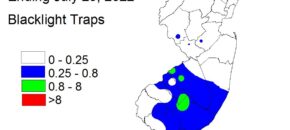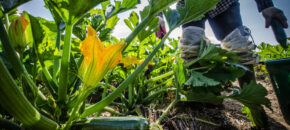After seeing a recent heat stress article appearing in the Plant and Pest Advisory, I was reminded of the need for heat stress management for animals. The following article appeared in the pages of the Hoard’s Dairyman magazine. Steve Martin from DNMCMILK give some good guidelines for managing the dairy herd. Click on Heat Stress […]
Continue reading...Vegetable IPM Update 07/20/22

Sweet Corn European corn borer (ECB) moth catches continue to be extremely low around the state. We are in between adult generations at this time. ECB population maps will resume if second flight catches rise to high enough numbers. The highest nightly trap catches of ECB for the week ending 07/20/22 are as follows: Allentown […]
Continue reading...Quick Tips to Beat the Heat

Daily high temperatures over the next 10 days will soar above 90 degrees each day, with the real feel exceeding 100 degrees at times. It’s important to take precautions to keep you and your workers safe from heat stress and other heat-related illnesses. Check out these 5 quick tips you can implement today to safeguard […]
Continue reading...FDA Proposes Compliance Date Extension for Pre-Harvest Agricultural Water Requirements
On July 18, 2022 the U.S. Food and Drug Administration (FDA) issued a supplemental notice of proposed rulemaking to extend the compliance dates for the pre-harvest agricultural water provisions as outlined in the recent 2021 agricultural water proposed rule. The 2021 agricultural water proposed rule, if finalized, will require farms to conduct annual systems-based agricultural water […]
Continue reading...Pumpkin Pollination and Weather Conditions

With high temperatures this week and predicted for next week, there are concerns about pollination of pumpkin and other crops. Flower bud abortion can occur if temperatures are in the high 70’s at night or in high 90’s during the day for several consecutive days. Heat stress causes other issues with plant functions and plant […]
Continue reading...Edema development in brassica crops
Edema is often expressed as off-color swellings or galls that appear on leaves and stems. Edema develops when epidermal cells hold excessive water due to a slowing of evapotransporation when hot, muggy days are followed by cooler, wetter weather. Edema develops because the plant takes in more water (due to a high soil moisture content) […]
Continue reading...